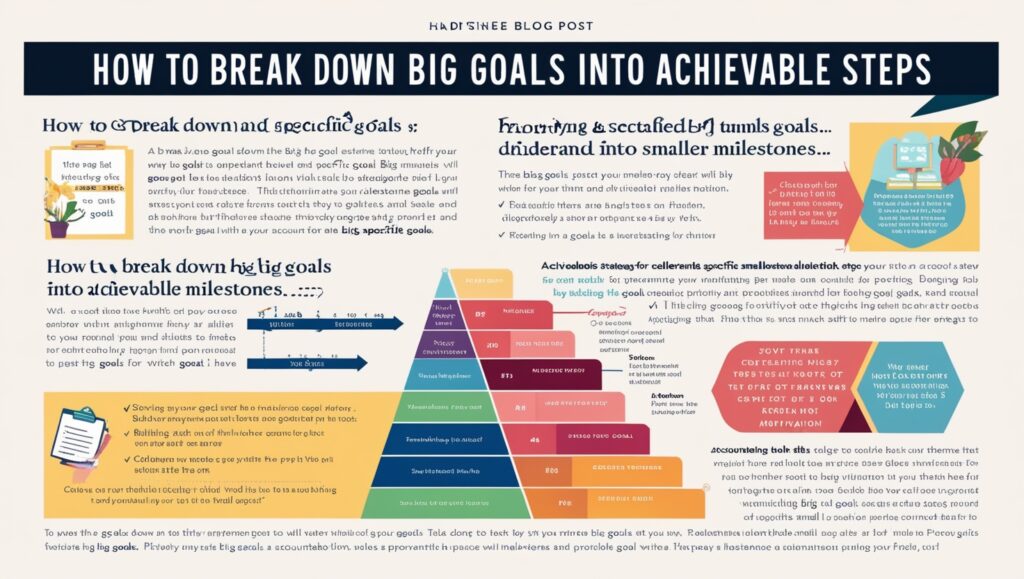How to Break Down Big Goals into Achievable Steps
Setting big goals can be exciting and motivating, whether you’re aiming to start a business, learn a new skill, or achieve personal milestones. However, the sheer size of these goals can often feel overwhelming. You might wonder where to start or how to stay on track. The key to success lies in breaking down your big goals into smaller, achievable steps. By doing so, you make them more manageable, measurable, and attainable.
In this blog, we’ll explore a step-by-step approach to breaking down large goals, offering practical strategies and actionable tips to help you turn your dreams into reality.
Why Break Goals into Steps?
Breaking down goals helps to:
- Reduce Overwhelm: Smaller tasks feel less intimidating and are easier to tackle.
- Build Momentum: Completing smaller tasks boosts motivation and confidence.
- Enhance Clarity: It becomes easier to see what actions are required to achieve your goal.
- Track Progress: Small milestones allow you to measure success and make adjustments.
- Stay Focused: A clear plan keeps you on track and prevents distractions.
Step-by-Step Guide to Breaking Down Big Goals
1. Define Your Big Goal Clearly
Start by defining your goal in specific terms. A vague goal like “get healthy” or “start a business” can be difficult to tackle. Instead, frame it in measurable and actionable terms, such as:
- Lose 20 pounds in 6 months through diet and exercise.”
- “Launch an online store with 20 products by the end of the year.”
2. Understand the Why Behind Your Goal
Ask yourself why this goal matters to you. Understanding your motivation will keep you focused during challenges. Write down your “why” and refer to it when you need inspiration.
3. Break It Down into Milestones
Divide your big goal into major milestones. These are key checkpoints that bring you closer to your final objective. For example:
Big Goal: Write a book.
Milestones:
- Research and outline the book.
- Write the first draft.
- Edit and revise the manuscript.
- Submit to publishers or self-publish.
Milestones give you a roadmap and help you see the journey in phases rather than as one massive task.
4. Identify Actionable Steps for Each Milestone
Once you’ve outlined milestones, break them further into actionable steps. Each step should be small enough to complete without feeling overwhelming.
Example Goal: Train for a marathon.
Milestones and Steps:
Milestone 1: Build a base fitness level.
- Step 1: Research a beginner’s running plan.
- Step 2: Run 3 times a week for 2 miles each session.
- Step 3: Add strength training twice a week.
Milestone 2: Increase weekly mileage.
- Step 1: Add 1 mile to weekly long runs.
- Step 2: Incorporate interval training once a week.
Milestone 3: Prepare for race conditions.
- Step 1: Run a half-marathon as a test.
- Step 2: Practice hydration and nutrition strategies.
5. Prioritize Your Tasks
Not all tasks are created equal. Identify which steps are most critical to progress and prioritize them. Use methods like the Eisenhower Matrix or Pareto Principle (80/20 rule) to focus on tasks that yield the highest impact.
6. Create a Timeline
Set deadlines for each milestone and task to create a sense of urgency and accountability. Be realistic about how long each step will take, and allow some buffer time for unexpected delays.
Tips for Scheduling:
- Use tools like calendars, planners, or project management apps (Trello, Asana).
- Break tasks into daily, weekly, or monthly goals.
- Review your timeline regularly and adjust as needed.
7. Build Habits Around Your Steps
Transforming tasks into habits makes it easier to stay consistent. For example, if your goal is to learn a new language, create a habit of practicing 15 minutes daily.
Habit Formation Tips:
- Attach the habit to an existing routine (e.g., practice vocabulary during your morning coffee).
- Use reminders and habit-tracking apps to stay consistent.
- Reward yourself for maintaining the habit.
8. Monitor Progress and Celebrate Wins
Regularly review your progress to ensure you’re on track. Evaluate what’s working and what needs adjustment.
Celebrate Small Wins:
Acknowledging achievements keeps you motivated. Whether it’s completing a chapter of your book or running your longest distance yet, take time to celebrate your progress.
9. Stay Flexible and Adapt
Life is unpredictable, and goals often require adjustments. If a task takes longer than expected or circumstances change, reassess your plan and adapt. Flexibility ensures you don’t lose sight of the bigger picture.
10. Keep Accountability
Share your goals with a trusted friend, family member, or mentor. Having someone to check in with can keep you accountable and motivated. Alternatively, join a group or community with similar goals for support and encouragement.
Common Challenges and How to Overcome Them
1. Procrastination
- Solution: Break tasks into smaller steps and start with the easiest one to build momentum.
2. Losing Motivation
- Solution: Revisit your “why” and visualize the benefits of achieving your goal.
3. Overwhelm
- Solution: Focus on one step at a time rather than the entire goal.
4. Lack of Progress
- Solution: Analyze your approach and adjust if needed. Seek feedback or guidance if you’re stuck.
Final Thoughts
Big goals are not achieved overnight, but with a clear plan and consistent effort, they can become a reality. Breaking down your goals into smaller, actionable steps makes them more manageable and increases your chances of success. By following the strategies outlined in this blog—defining clear goals, setting milestones, prioritizing tasks, creating habits, and celebrating progress—you can turn even the most daunting goals into achievable milestones.
Start today, take that first step, and watch your dreams unfold, one small success at a time. Remember, every great accomplishment begins with a single, intentional step!

